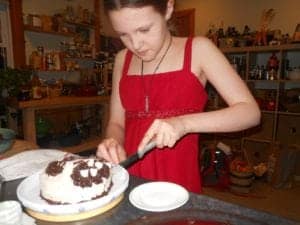Raising Healthy Children, Part 1
When we become parents, we suddenly realize, kids don’t come with instruction manuals! But let’s think about that in reverse: when you’re a kid, life DOES come with instructions. Those instructions come from your parents, primarily, and other family, teachers, and later peers. A few hundred years ago, even here in America, those instructions absolutely included a quite thorough knowledge of what wild plants were edible, which were good as medicine, how to kill an animal with respect, how to cook effectively, and what to eat. Even 75 years ago, those instructions almost certainly still included how to garden, and how to cook, and what to eat.
What are those instructions today? Few families still have gardens (though the number is growing!). Few families prepare and eat their meals together. Few, in fact, prepare meals at all – most families eat takeout several times a week. In most families, both parents work, and by the time kids are picked up from after-school programs, there’s really only time to eat and do homework and get to bed. Even instructions around sleep are scarce: most children grow up watching their parents caffeinate to compensate for too little sleep, and many children aren’t getting the sleep they need either.
What’s the result? Our children are growing up able to program computers but with no notion of what it takes to make a healthy body, and as a larger consequence, a healthy society, or a healthy earth.
Wow, Katja, this is an awfully cheerful article you’re writing…
But actually, it is! Because it’s never too late to start teaching our children what they need to know, and not only that! Children are often more strongly influenced by peer groups than by parents. So the lessons you teach your child today can impact his or her whole circle of friends!
At a very young age, we can teach children to understand that upset tummies can be the result of too much junk food. We can teach them that illness can be a result of eating poorly and not sleeping enough. We can teach how to take action to resolve these problems and also how to prevent them from happening in the future. These lessons are simple, but they start the process of thinking about the effect of their actions and their choices on their own health.
Children, even those who do not watch much television, are exposed to tremendous amounts of marketing, and much of the marketing targeted at children is for food products. You may have found that your children prefer products that come in packages as opposed to “plain” fruits and vegetables that you may have eaten when you were young. Instead of snacking on a carrot or an apple, they would rather have chips, or “fruit snacks” – which are little more than fruit-flavored candy!
When children understand the importance of eating real food, they can – and surprisingly, will! – make choices that are healthier for them. More importantly, when children understand the way their food choices affect their bodies, they will make better choices when you’re not around, as well!
We can teach children to value sleep and the importance sleep plays in good health. When they understand what their bodies are doing when they’re asleep, it is easier for them to accept bedtime.
We can teach our children very simple plant remedies for common illnesses. Even if children only know a few herbal remedies, it sets a foundation of self-care – instead of a reliance on chemicals – that will last their lifetime.
And if children learn at a young age to listen to what their bodies are telling them, they are better able to stand up to peer pressure and less likely use tobacco, drugs, and alcohol. When they understand their bodies and when they have the knowledge and skills to care for their bodies, they are more grounded and rooted in self-confidence and self-reliance. When children respect their own bodies, they are more likely to respect the bodies of others, and are thereafter more likely to respect animals, plants, and our environment here on Earth.
OK, well, that sounds a whole lot more hopeful now. But just how, exactly, do you propose we teach these things?
Start simple! You don’t have to be fancy or complicated to start teaching your children about good health. You don’t even have to know much about it yourself! Start with the simple ideas in the next four installments of this series, and follow wherever the interest grows – together!
Read the rest of the series:
For a complete guide to navigating adolescence and herbs for teens, check out our Supporting Kids Through Puberty course! It includes webinar-style and standard video sessions chock full of strategies to make the years of puberty more peaceful for everyone in the family. By the end of this program, you’ll know dozens of ways to incorporate herbs into your teen’s food, drinks, and self-care routines to keep them (and you!) healthy and resilient as they transition into adulthood.
This article was originally written for mommypotamus.

Join our newsletter for more herby goodness!
Get our newsletter delivered right to your inbox. You'll be first to hear about free mini-courses, podcast episodes, and other goodies about holistic herbalism.



